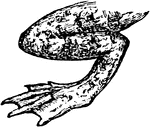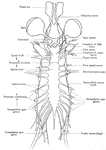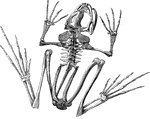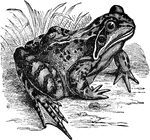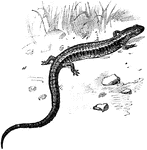Clipart tagged: ‘amphibian’

Archegosaurus Head
Archegosaurus is a genus of amphibian which lived during the Asselian to Wuchiapingian ages of the Permian,…

Dorsal Vertebrae of the Archegosaurus
Archegosaurus is a genus of amphibian which lived during the Asselian to Wuchiapingian ages of the Permian,…

Axolotl
"Ten to fiteen inches long, of a brownish or grayish color, spotted with black. On each side of the…

Brain of an Alligator
In Amphibians the nervous system is but slightly developed. The cerebrum is small; the cerebellum is…

Dorsal Vertebra of Branchiosaurus
Branchiosaurus (Greek for "gill lizard") is a genus of small, lightly-built early prehistoric amphibians.…
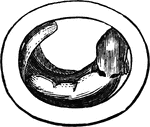
Embryo
"Figure 1 represents the embryo as it appears several days after the egg is deposited." — Goodrich.…

Form of the embryo
"Figure 2 gives an outline of its form; the arrows at the side of the head show the currents of water…
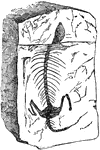
Fossil
This illustration shows the ancient fossile of an amphibian. Fossils are the mineralized or otherwise…

Leg of Frog
This illustration shows the leg of a frog. P. Pelvis, FE. Femur, TI. Tibia, FI. Fibula, TA. Tarsus,…
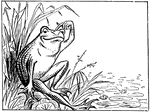
Frog Sitting on Bank and Scratching Head
An illustration of a frog sitting on the bank of a pond and scratching his head.
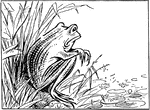
Frog Sitting on Bank Looking at Pond
An illustration of a frog sitting on the bank of a pond looking out into the water.
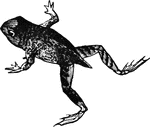
Frog with tail
Nearing the end of its development, a gradually shrinking tail is all that remains of the tadpole.
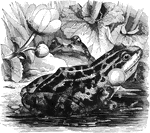
Edible frog
"It is rather larger than the common frog, and its nocturnal croakings are so loud and disagreeable,…
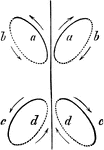
Ellipses of Swimming Frog
A diagram showing the motions a young frog makes while swimming. In this stage of life, the frog makes…
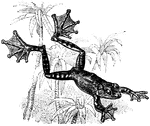
Flying Frog
The flying frog is an amphibian "having enormously long webbed toes, enabling it to sustain a kind of…

Loops of Swimming Frog
A diagram showing the motions a young frog makes whilst swimming. In this stage of the frog's life,…
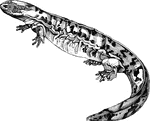
Alleghany hell-bender
"It is one to two feet long, dark slate color, feeds on worms, crawfish, fishes, and aquatic reptiles.…

Vertebral Column of Hymenochirus
African dwarf frogs of genus Hymenochirus, also known as dwarf aquatic frogs, are frogs native to Sub…
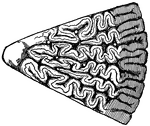
Section of Tooth of Typical Labyrinthodont
This illustration shows a section of a tooth of a typical Labyrinthodont. Labyrinthodont, or Stegocephali…

Siren lacretina
"Two feet long, black above and dusky beneath. It is of an eel-like form, lives in the muddy water of…
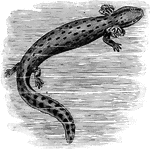
Common Mudpuppy
The Common Mudpuppy (Necturus maculosus) is a species of aquatic salamander found throughout the northeastern…

Crested Newt
"In the newt a tail is superadded to the extremities, the tail and the extremities both acting in swimming."—Pettigrew,…
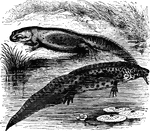
Smooth newt
"It is three and a half inches long, the skin smooth as a frog's; it lives in ponds and ditches, and…

Mud Puppy
The mud puppy has two pairs of legs. It also has persistent external gills. It can attain a length of…
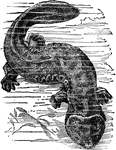
Salamander
"Salamander is a genus of reptiles closely allied to the frog, from which it differs in having an elongated…

Salamander
A class of animals allied to the newts, which closely resemble the lizards. Many species have been described.…
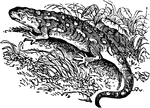
Cold Blooded Salamander
The name given to various animals included in the class Amphibia and in the order Urodela of that class.…

Land-Salamander
"Salamanders have the honor of appearing prominently in fabulous narratives. The Greeks believed that…

Violet-colored salamander
"Is five to seven inches long,; blueish-black, with bright yellow spots; habits nocturnal, living under…

Salamanders
"The Land Salamanders, unlike the Tritons, are ovo-viparous, though the young at first inhabit the water…

Types of Seashore Life
24. Various corals, 25. Razor-shell, 26. Cockle, 27. Various winkels, 28. Shore crab, 29. Father lasher,…
Newly hatched tadpole
"Figure 5 shows the form of the tadpole when first hatched, which usually takes place about four weeks…

Common European toad
"It is a harmless animal, though its ungainly appearance has made it the subject of general aversion."…
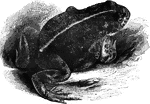
Natter-jack toad
"Resembles the common toad of Europe in appearance: there are also other foreign species, among which…

Squirrel Tree-toad
"Is of a brownish or light ash-color, and is found under logs and the bark of decayed trees." — Goodrich,…

Surinam toad
"At the breeding season the back of the female exhbits a number of small pits; into these pits the male…
